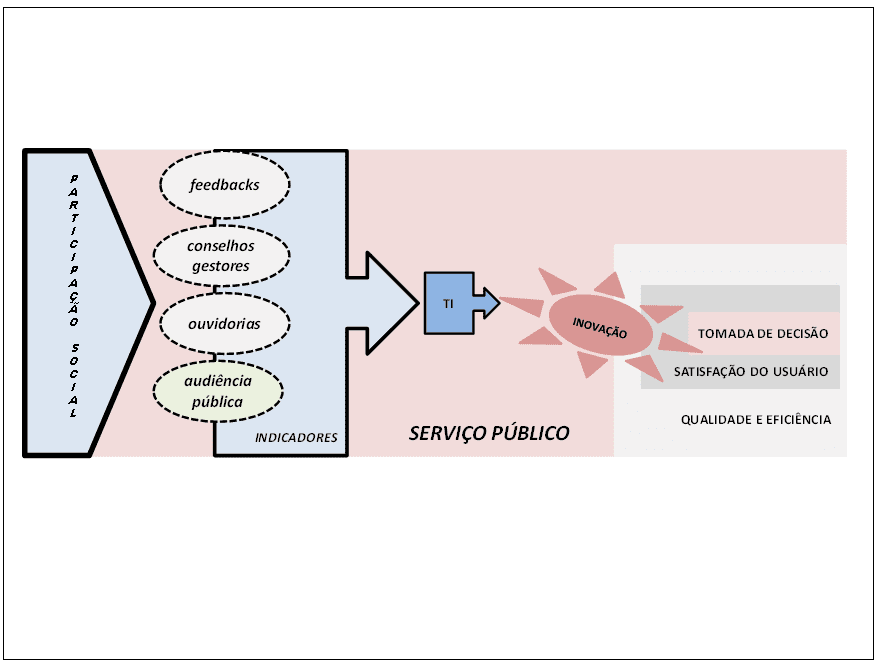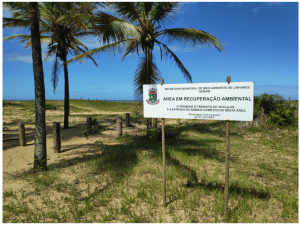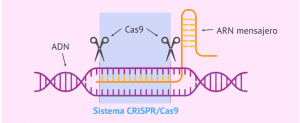ORIGINAL ARTICLE
REBELO, Michele Alves Correa [1], BIZATTO, Francieli Alves Correa [2]
REBELO, Michele Alves Correa. BIZATTO, Francieli Alves Correa. Popular participation: Reflections on the potential of innovation in the public service. Revista Científica Multidisciplinar Núcleo do Conhecimento. Year 05, Ed. 10, Vol. 15, pp. 05-17. October 2020. ISSN: 2448-0959, Access Link: https://www.nucleodoconhecimento.com.br/law/potential-of-innovation, DOI: 10.32749/nucleodoconhecimento.com.br/law/potential-of-innovation
SUMMARY
The democratization process reduced the role of the State. The institutionalization of some channels of consultation and evaluation provoked reflections on the effectiveness of popular participation in the formulation of improvements, implementation of new public policies and innovation of public services. Democratic contribution can occur through management councils, ombudsman offices, public hearings, among others. Thus, the article seeks to identify the possibilities of innovation in the public sector through popular participation. For the development of this work, the exploratory research method of qualitative nature was used. The importance of the theme is based on the need to understand the ambivalences of the social processes and attitudes of the actors involved, both in the experiences that innovate in the management of the public thing, as well as in those that keep the traditionally developed practices unchanged. The analysis focuses on the potential for innovation of the public service through an effective popular participation, through feedbacks and institutionalized channels, aiming to mark the rupture of the current way of managing. Social participation can influence the expansion of spaces for participation, the inclusion of new demands, decision-making and, consequently, provide innovation in the public sector. Despite the need for empirical studies and research to corroborate the dynamics of public service innovation through the effective participation of the user.
Keywords: popular participation, public service, innovation.
1. INTRODUCTION
The Federal Constitution of 1988 incorporated several modalities of social participation in the state’s performance, which is why it gained prominence as a Citizen Constitution. Since then, public law has undergone major transformations, requiring the review and analysis of institutes and public policies used in administrative management.
Social participation became, from the 1990s on, one of the organizational principles acclaimed by national and international agencies, of the processes of public policy formulation and deliberation (MILANI, 2008). And it can occur through management councils, ombudsman offices, public hearings, among other channels.
According to Rocha (2008), the participation of society in public management facilitated the creation of institutional mechanisms aimed at consolidating democratic values, transparency and social control of state action.
For Humberto Martins, president of the STJ (Superior Justice Tribunal), advertising and transparency allow society to know the operation of the state machine, in terms of costs (efficiency) and execution of its purposes (effectiveness).
Article 5 of Law No. 12,527/2011, called the Transparency Law or The Law on Access to Information, reaffirms that “it is the duty of the State to guarantee the right of access to information, which will be franchised, through objective and agile procedures, in a transparent, clear and language of easy understanding”.
Federal Law 13,460 of 2017 established rules for popular participation, providing for ways of protecting and defending the rights of the user, reinforcing the importance of the institute.
This provision corroborates the duty of the State to the citizen to provide the information, and represents an important advance in favor of the recognition of citizenship values. In this context, it is worth emphasizing the importance of information and communication technology for the realization of these rights.
It is worth remembering that before the 1988 CF, the hegemonic perception that corruption was a widespread phenomenon persisted in Brazil, a scenario resulting from the scarcity of mechanisms to control state activity and the lack of initiatives to promote access to information.
Despite the institutionalization of the consultation of “organized civil society” in various processes of public policy formulation, it is necessary to reflect on the effectiveness of this popular participation in the formulation of improvements, implementation of new public policies and, mainly, in the innovation of public services.
In this way, the article seeks to identify the possibilities of innovation of the public service through popular participation, in the following aspect: Would user participation be tools capable of providing public service innovation and assisting in decision making?
The analysis of the theme focuses on the potential of innovation through effective popular participation, through feedback, evaluation and institutionalized channels.
Thus, it is clear the relevance of the theme and the need to understand the ambivalences of the social processes and attitudes of the actors involved, both in the experiences that innovate in the management of the public thing, as well as in those that keep the traditionally developed practices unchanged.
For the development of this work, the exploratory research method of qualitative nature was used.
The work is composed of five sections, in which the first refers to this introduction, which presents the contextualization and the research question. The second, third and fourth sections present the categories of popular participation analysis, public service and innovation, respectively. Finally, the fifth section contemplates the conclusions.
2. POPULAR PARTICIPATION
Brazil has become a Democratic State of Law, since the Federal Constitution of 1988, which has citizenship among its foundations (art.1°, II). On that expression, Lazzarini (2001, p. 106) states that “it is a quality and a right of the citizen who, as such, has the legal condition that individual or legal persons bear in relation to the State they belong to”.
For the exercise of this plea, the right to participation, provided for in Article 37, §3,§3, “The law shall discipline the forms of participation of the user in the direct and indirect Public Administration” was established in the Magna Carta. This standard was regulated by Federal Law 13,460 of 2017, which established rules for the participation, protection and defense of user rights.
In Articles 5, item XXXIII and art. 216, § 2 of the CF (federal Constitution) /88, the reasons for access to information are provided for. Having the publication of Federal Law No. 12,527, called the Transparency Law or Access to Information Law, which created mechanisms to provide greater transparency to the acts of public administration.
At a time when the State allows the citizen access to information, it is possible to verify whether the actions of the state entity are being aimed at meeting the needs of society, and, consequently, in view of the public purpose.
Silva (2009) brings the idea of a new citizenship in a system of representative democracy, in which the citizen controls political power and administrative management, thus finding himself an important function.
It is not persnated in a Democratic State of Law, where power is exercised in the name of the people, that it be deprived of information regarding the management of the public thing (MELLO, 2009).
Among the modalities of popular participation, the satisfaction survey can provide the public manager with an evaluation of the performance of the servers from the user’s perspective and a tool for the development of management strategies.
The opinion of those who use the public service is an important element, not only as an indicator of quality, but because it is potentially related to the adequacy in the use of this delivery.
There is an expectation on the part of governments around the world that public organizations should constantly innovate to improve their performance in order to improve the administrative efficiency of available resources and improve the care of the population.
This year, due to the COVID-19 pandemic, the importance of Information Technology (IT) in public management, for the delivery of public services and access to information was observed. Governments reorganized, in record time, human resources with the implementation of technological solutions, adjusting management processes and resformulating communication capacity.
Some public demands are intertwined and for this reason interfere in the result of public services delivered to the citizen, and an organizational advance is necessary for the integration of resources, experiences and, mainly, information between public agencies.
Regardless of the participatory mechanism used, there is still a long distance to be traveled between the public manager and the citizen, and empirical research is needed in the public sector to evaluate the most used forms of popular participation, whether they are effective and which public is interested in giving constructive or critical feedback.
Another interesting bias to be researched is the use and destination of feedback sent to the public administration, in order to determine whether these interfere in the decision-making of the manager and whether he shares with the team about popular insight.
The public service category will be displayed below.
3. PUBLIC SERVICE
In the 19th century, from the French Revolution, the legal institute of the public service emerged. Maurice Hauriou and Montesquieu were the forerunners of the study of administrative law and state functions (MERINELLA, 2019). The first school to deal with the subject was the School of Public Service, led by Frenchman Léon Duguit (NOHARA, 2017).
The competence for the provision of public services is distributed in the three spheres of public administration: federal, state and municipal. The CF of 1988, in Article 175 determines the form of provision of the service (direct and indirect) by the federative entity itself or by delegation, in the modalities of permission, concession and authorization, under the supervision of the state entity, aiming at meeting collective needs (MEYRELLES, 2001).
This constitutional article was regulated by Federal Law 8.987/95, which brings in its bulge the “Adequate Public Service” as one that meets the principles of current affairs, safety, modesty, safety, continuity, generality and efficiency, resulting in quality.
A state action will only be legally efficient when its quantitative and qualitative result is satisfactory, taking into account the possible universe of meeting existing needs and the available means (CARDOZO, 1999).
The principle of efficiency stands out in two aspects: performance improvement to obtain excellent results and the way of organizing, structuring and discipline of management acts, for the achievement of qualifying deliveries (DI PIETRO, 2017).
Public services have as main characteristic the relationship of direct responsibility with society, and to do so, it constantly needs to redefine its mission (ETEFANO, 1996).
After the publication of Law 13,430 of 2017, the user of the public service ceased to be a mere spectator and began to have a leading role. In this sense, popular participation in state actions, such as the use of feedback, is an innovative potential for decision making and, if this participation is effective, it can add knowledge to the manager.
The quantification of the modalities of public information collection and their treatment through IT represents the guarantee of accuracy of the results, avoiding distortions of analysis and interpretations. In this logic, there will be the reduction of risks, enabling the use of public resources in what will actually add to the public service.
Therefore, it is necessary to encourage and enable popular participation in public bodies to enable changes in decision-making and, thus, encourage innovation, whose category will be addressed below.
4. Innovation
This is a term of multidimensional nature and multidisciplinary approaches. Its concept has been presented profusely in academia and, mainly in business.
The term “innovation” gained popularity in the economy when joseph Schumpeter published the theory of economic development, published in 1912, in which it presents the term creative destruction, referring to the capitalist system, where the old structures are destroyed and replaced by new ones, relating the endogenous capacity of the system to produce innovation.
Society invents itself and reinvents itself at every moment, which is why organizations need to be prepared for the needs of the market, in addition to environmental dynamism and complexity.
In the public sector, especially, the functions of the State are related to social demands, which, in turn, are influenced by technological, economic and, mainly, political advances, due to electoral cycles. They add to these factors, other aspects that hinder the innovation process, such as organizational culture, bureaucracy resulting from legislation and stability.
As a result of technological advances, a networked society is perceived, in which the government must follow. In this sense, the public sector lacks new skills, knowledge, skills and attitudes, so that there is the incentive of routines and processes to support the generation of new products and services aimed at a change.
To this end, it will be important for public managers to be adept at such changes, breaking paradigms in the way of managing the public thing, since innovation can mean better services provided to citizens and influence performance.
The demands of the public sector are more complex and transversal, requiring swift solutions and integration between government agencies. In this context, social participation, through the management councils, ombudsman offices, public hearings, among others can serve as a stimulus to the manager for decision making.
Social participation can influence the expansion of spaces for participation, the inclusion of new demands, decision-making and, consequently, provide innovation in the public sector.
Figure 1 represents this assertion.

Porter (1986) highlights the importance of organizations defining goals and objectives, to obtain the identification of strengths and weaknesses, to further define internal limits, opportunities and threats, to learn how to compete, seeking continuous improvements, with the aim of overcoming the barriers inherent to change and innovation.
5. FINAL CONSIDERATIONS
The research presented a brief review and synthesis of the literature on the potentialities of innovation through effective popular participation, through feedbacks and institutionalized channels.
The importance of the theme is based on the need to understand the ambivalences of the social processes and attitudes of the actors involved, both in the experiences that innovate in the management of the public thing, as well as in those that keep the traditionally developed practices unchanged.
Social participation can influence the inclusion of new demands, interfere in decision-making and, consequently, provide innovation in the public sector, since the administration acts not only in the defense of their individual interests, but also in the protection of the collective interest, so much so that the Federal Constitution brings instruments of action to be used for this purpose (DI PIETRO, 2015).
In this sense, the evaluation, through feedback, is a tool capable of issuing statistical data important for decision making. Once inserted in the organizational context, all actors involved in the tripod: public power, user and server can achieve satisfactory results.
Public management should build a specific model in view of the evaluations exposed by service users, allowing decisions related to public policies to be based on effective data, reliable from popular participation and, more importantly, shared by the public manager for the execution team.
In order to have an environment conducive to innovation, it is important to encourage the development of skills, transversal skills, decentralization of demands and the integration of knowledge.
It is concluded that the approach has value and presents a series of propositions to be tested through empirical studies, in addition to some more general challenges for researchers who want to further deepen the theme.
6. REFERENCES
ANDRADE, J. A. O Processo de Inovação nas Organizações Públicas: integrando conceitos às práticas. In: Encontro Nacional dos Programas de Pós-Graduação em Administração – ENANPAD, 2001, Campinas. Anais do XXV ENANPAD, 2001.
BANDEIRA, Pedro. Participação, Articulação de Atores Sociais e Desenvolvimento Regional. Brasília: IPEA, 1999.
BATISTA, Fábio Ferreira Modelo de gestão do conhecimento para a administração pública brasileira: como implementar a gestão do conhecimento para produzir resultados em benefício do cidadão. Brasília: Ipea, 2012. Apud APO – ASIAN PRODUCTIVITY ORGANIZATION. Knowledge management: facilitator´s guide. 2009. Disponível em: <http://www.apo-tokyo.org/00e-books/ IS-39_APO-KM-FG.htm.
BEZERRA, Maria do Socorro Coelho; CAVALCANTI, Pettson de Melo. Transparência na administração pública: instrumentos legais e outros dispositivos. Revista Jus Navigandi, ISSN 1518-4862, Teresina, ano 17, n. 3242, 17 maio 2012. Disponível em: https://jus.com.br/artigos/21794. Acesso em: 15 out. 2020.
BINENBOJM, Gustavo. A Constitucionalização do Direito Administrativo no Brasil: Um Inventário de Avanços e Retrocessos. Revista Eletrônica sobre a Reforma do Estado (RERE), Salvador, Instituto Brasileiro de Direito Público, no. 13 março/abril/maio, 2008. Disponível na Internet: <http://www.direitodoestado.com.br/rere.asp.
BRASIL, Constituição da República Federativa do Brasil de 1988. Brasília: Planalto, 1988. Disponível em:<http://www.planalto.gov.br, acessado 12/08/2020.
BRASIL. Lei n. 12.527, de 18 de novembro de 2011. Brasília: Planalto. Disponível em:http://www.planalto.gov.br, acessado 12/08/2020.
BRASIL. Lei n. 13.460, de 18 de junho de 2017. Brasília: Planalto. Disponível em:http://www.planalto.gov.br, acessado 11/08/2020.
BRESSANT, J; TIDD, J. Inovação e empreendedorismo. Porto Alegre. Bookman, 2009.
CAMPELO, Graham Stephan Bentzen: Administração pública no Brasil: ciclos entre patrimonialismo, burocracia e gerencialismo, uma simbiose de modelos. Ci. &Tróp., Recife, v.34,n. 2, p.297-324, 2010.
CARNEIRO, R., and MENICUCCI, TMG. Gestão pública no século XXI: as reformas pendentes. In FUNDAÇÃO OSWALDO CRUZ. A saúde no Brasil em 2030 – prospecção estratégica do sistema de saúde brasileiro: desenvolvimento, Estado e políticas de saúde [online]. Rio de Janeiro: fiocruz/Ipea/Ministério da Saúde/Secretaria de Assuntos Estratégicos da Presidência da República, 2013. Vol. 1. pp. 135-194. ISBN 978-85-8110-015-9.
CGU – Controladoria Geral da União. Controle Social: Orientações aos cidadãos para participação na gestão pública e exercício do controle social. 3. ed. Coleção Olho Vivo. Brasília: Positiva, 2012.
CUNHA, Maria Isabel de. Inovações pedagógicas: o desafio da reconfiguração de saberes na docência universitária. Cadernos de Pedagogia universitária. Universidde de São Paulo, 2008.
DE PAULA, Ana Paula Paes. Entre a Administração e a Política: os desafios da gestão pública democrática. Campinas. São Paulo: 2003.
DI PIETRO, Maria Sylvia Zanella. Direito administrativo. 28. ed. São Paulo: Atlas, 2015.
ESPERIDIÃO, M.; TRAD, L.A.B. Avaliação da satisfação de usuários. Ciênc. saúde coletiva. Rio de Janeiro, v. 10, supl, p. 303-312, 2005.
ESTEFANO, E. V. V. Satisfação dos recursos humanos no trabalho: um estudo de caso na biblioteca central da Universidade Federal de Santa Catarina. 1996. Dissertação (Mestrado em Engenharia) — Universidade Federal de Santa Catarina, Florianópolis.
FERREIRA FILHO, J.S. et al. Avaliação de qualidade de serviços de saúde mental no Município de Niterói – RJ. A satisfação do usuário como critério avaliador. J Bras Psiquiat., Rio de Janeiro, v. 45, n. 7, p. 393-402, 1996.
FIGUEIREDO, Vanuza da Silva; SANTOS, Waldir Jorge Ladeira dos. Transparência e controle social na Administração Pública. In Revista de Contabilidade e Controladoria, v. 6, n 1.Universidade Federal do Paraná. Curitiba, jan./abr. 2014. Disponível em:< http://revistas.ufpr.br/rcc/article/viewFile/32082/22668>. Acesso em: 12/08/2020.
LUSTOSA DA COSTA, Frederico e Elza Marinho: Nova história da administração pública brasileira: pressupostos teóricos e fontes alternativas . Rev. Adm. Pública — Rio de Janeiro 50(2):215-236, mar./abr. 2016 – Universidade Federal Fluminense /Programa de Pós-graduação em Administração
LUSTOSA DA COSTA, Frederico: Prefácio a uma história da Administração Pública Brasileira. EnAPAD, RJ, 2008.
MARINELA, Fernanda. Direito administrativo. Niterói: Impetus, 2011.
MEIRELLES, Hely Lopes. Direito administrativo brasileiro. São Paulo: Malheiros, 2001.
MELLO, Celso Antônio Bandeira de. Curso de direito administrativo. 26. ed. São Paulo: Malheiros, 2009.
MENDES, V. L. P. S. Inovação gerencial em serviços públicos de saúde e Cidadania. Brasília: Ministério da Saúde – Secretaria de Assistência à Saúde, 2002.
MUNRO, A. C. M. Divergências entre as expectativas do usuário e a percepção da gerência em relação a qualidade do serviço. 1994. Dissertação (Mestrado em Marketing) — UFRGS, Porto Alegre. Disponível em: www.cesusp.ufrgs.br/PPGAmkres.
NOHARA, Irene Patrícia. Direito administrativo. 7. ed., atual. e ampl. São Paulo: Atlas, 2017.
OSBORNE, D. e GAEBLER, T. Reinventando o Governo: Como o Espírito empreendedor está Transformando o Setor Público. Brasília. MH Comunicação. 1995.
PAES, Ana Paula Paes de. Por uma nova gestão pública: limites e potencialidades da experiência contemporânea. Rio de Janeiro: Editora FGV, 2005.
PALUDO, Augustinho. Administração Pública para Auditor Fiscal da Receita Federal e Auditor Fiscal do Trabalho. Rio de Janeiro: Campus-Elsevier, 2012.
PORTER, Michael E. A vantagem competitiva das nações. 5 ed. Rio de Janeiro: Campus, 1989.
_________ Michael E. Estratégia competitiva: técnicas para análise de indústrias e da concorrência; tradução de Elizabeth Maria de Pinho Braga; revisão técnica de Jorge A. Garcia Gomez. 7ª ed. Rio de Janeiro:Campus, 1986.
PEREIRA, José Matias. Curso de gestão estratégica na administração pública. São Paulo: Atlas, 2012.
PIENING Erk. P. Dynamic Capabilities in Public Organizations. Public Management Review, 2011, 15:2, p. 209-245.
PIENING, Erk. Insights into the Process Dynamics of Innovation Implementation.The Case of Public Hospitals in Germany.Public Management Review – PublicManag Rev. 13. 127-157. 10.1080/14719037.2010.501615, 2011.
PINHO, J. A. G. de; SANTANA, M. W. Inovação na Gestão Pública no Brasil: uma aproximação teórico-conceitual. In: Encontro Nacional dos Programas de Pós-Graduação em Administração – ENANPAD, 1998, Foz do Iguaçu. Anais do XXV ENANPAD, 1998.
RICHARDSON, Roberto J. (Cood.). Pesquisa social: métodos e técnicas. 4ª. ed. São Paulo: Atlas, 1999.
ROCHA, E. A Constituição Cidadã e a institucionalização dos espaços de participação social: avanços e desafios. 2008. Disponível em: <Disponível em: http://www.ipea.gov.br/participacao/images/pdfs/participacao/outras_pesquisas/a%20constituio%20cidad%20e%20a%20institucionalizao%20dos%20espaos%20de%20participao%20social.pdf.
SILVA, Carlos Eduardo de Souza. Autonomia de gestão e concorrência: em busca de novas formas de gestão do setor público em um contexto pós-fordista. Rev. adm. pública, v. 28, n. 3, p. 211-228, 1994.
SILVA, Thiago Antunes: Conceitos e Evolução da Administração Pública: O Desenvolvimento do Papel Administrativo. Revista: Territórios, Redes e Desenvolvimento Regional: Perspectivas e Desafios Santa Cruz do Sul, RS, Brasil, 13 a 15 de setembro de 2017 – VIII Congresso Internacional de Desenvolvimento Regional
SILVA, T. S.; LIMA, A. A. T. F. C.; GOMIDE, C. S. A. Inovação na Administração Pública: Um Meta Estudo dos Anais do Enanpad. Revista Capital Científico – Eletrônica, volume 15, n. 1, p. 1-19, 2017.
SILVA, Elke Andrade Soares de Moura. Controle externo, controle social e cidadania. Revista do Tribunal de Contas do Estado de Minas Gerais, Minas Gerais, p. 46 -57. 2009. Disponível em:<http://revista.tce.mg.gov.br/Revista/Buscar.
ZIELINSKI, Dioleno Zella; COSTALDELLO, Angela Cassia. Controle social da administração pública: a lei de acesso à informação como fator de atenuação da assimetria informacional característica das relações de agência. Direito e administração pública II, Paraíba, p. 179-201, nov. 2014. Disponível em:<http://publicadireito.com.br/publicacao/ufpb/livro.php?gt=194. Acesso em 12 ago. 2020.
[1] Professional master’s degree in Public Policy Management. University of Vale do Itajaí, UNIVALI, Brazil. Specialist in Public Security Management – UNISUL. Palhoça (SC). Law degree. University Center of Brusque, UNIFEBE, Brazil. Member of the Research Group of Acadepol – Management Intelligence Center. Professor of the Postgraduate Course in Public Security Management and Applied Criminal Investigation.
[2] Professional master’s degree in Public Policy Management. University of Vale do Itajaí, UNIVALI, Brazil. Specialization in Specialization Labor Market. University of Vale do Itajaí, UNIVALI, Brazil. Law degree. University Center of Brusque, UNIFEBE, Brazil.
Submitted: October, 2020.
Approved: October, 2020.


